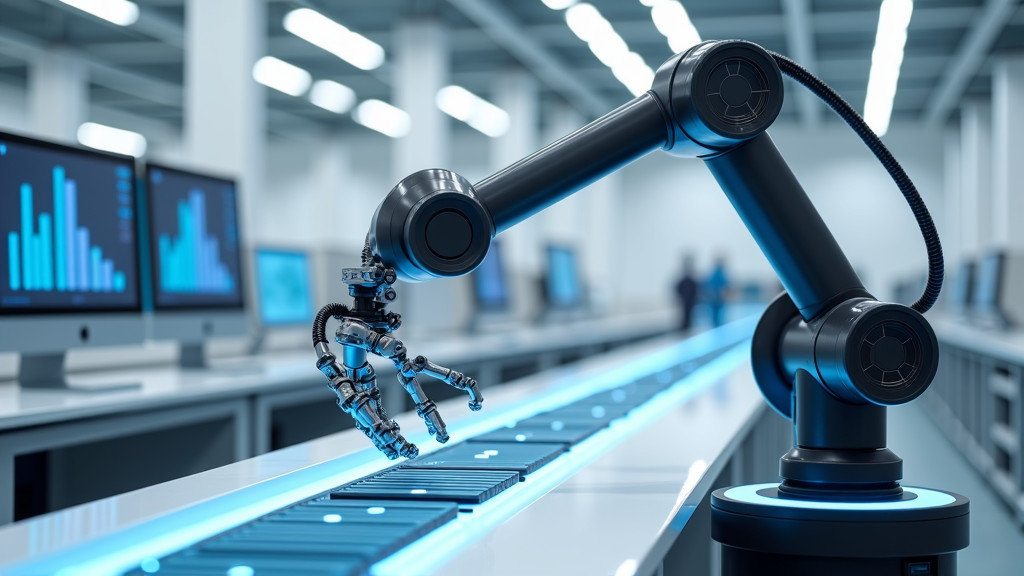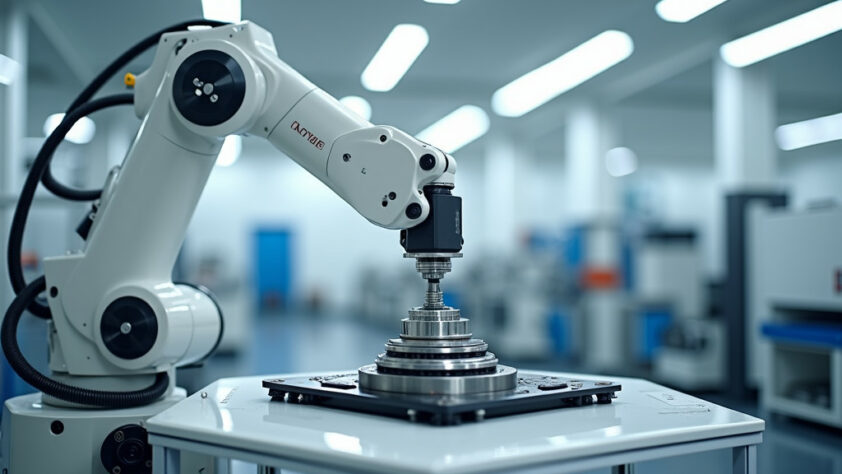Imagine a world where machines effortlessly perform complex tasks, production lines run with precision, and industries achieve new levels of efficiency. This is the reality shaped by automation engineering. At its core, automation engineering involves creating systems that minimize human intervention while maximizing productivity and accuracy.
Automation engineering merges programming, mechanical engineering, and electrical engineering. This field has evolved significantly, transforming industries and redefining possibilities in manufacturing, robotics, and more. But why is it crucial today?
Its significance lies in its ability to enhance efficiency. By designing and implementing automated systems, automation engineers create a more streamlined, productive future. They develop machines that perform repetitive tasks, craft algorithms for split-second decisions, and push technological boundaries.
This exploration delves into the vital role of automation engineers in shaping technology. We’ll see how their work affects everything from cars to smartphones. Discover the evolution of automation tools and methodologies that have brought us to this exciting point in technological history.
Whether you’re a tech enthusiast, an aspiring engineer, or simply curious about modern industry, join us on a journey through the world of automation engineering—a field actively creating the future.
Core Responsibilities of Automation Engineers


Automation engineers play a pivotal role in transforming business operations across various sectors. Their main mission is to craft, maintain, and fine-tune automated workflows that streamline processes and boost productivity. Here are the key responsibilities that define this dynamic profession.
Creating automated systems is central to an automation engineer’s role. These professionals use their software development expertise to replace manual tasks with efficient automated processes. Imagine a manufacturing plant where an automated vision system performs quality checks with speed and accuracy instead of manual inspections.
Maintenance is another crucial aspect of an automation engineer’s duties. These engineers nurture and update automated systems to ensure peak performance. This care includes troubleshooting issues, applying software patches, or recalibrating sensors for optimal functionality.
Optimizing for Peak Performance
Optimization is where automation engineers shine. They analyze existing workflows to enhance efficiency and productivity. This could involve tweaking algorithms, implementing machine learning models, or integrating new technologies to expand capabilities.
For example, in an e-commerce fulfillment center, an automation engineer might optimize the order picking process by implementing a smart routing system that guides robots along efficient paths, reducing fulfillment times and increasing throughput.
| Strategy | Description |
|---|---|
| Path Optimization | Programming robots to take the most efficient routes to reduce cycle times and energy consumption. |
| Cycle Time Reduction | Streamlining operations to minimize unnecessary movements and dwell times. |
| Simulation and Modeling | Using digital twins to evaluate system behavior under specific conditions for continuous optimization. |
| Data Monitoring and Collection | Integrating sensors for real-time data collection to enhance system performance and predict maintenance needs. |
| PLC-Based Optimization | Using PLCs to orchestrate complex sequences, refine workflows, and enable predictive maintenance. |
| Standardization and Optimization | Establishing clear, repeatable processes and enhancing them for efficiency before automation. |
Testing is vital in an automation engineer’s toolkit. They develop and execute comprehensive test plans to ensure systems function flawlessly under various conditions, identifying and rectifying potential issues before they impact operations.
Automation is not about replacing humans, but about empowering them to focus on higher-value tasks that require creativity, critical thinking, and emotional intelligence.
Collaboration is key in automation engineering. Engineers work closely with cross-functional teams, including software developers, data scientists, and domain experts, to create holistic solutions that address complex business challenges. This teamwork ensures systems align with organizational goals and user needs.
Staying ahead of emerging technologies is essential for automation engineers. They must be aware of developments in artificial intelligence, machine learning, and IoT devices. This constant learning allows them to integrate cutting-edge tools into their solutions, driving innovation across industries.
Automation engineers are the unsung heroes, creating a more efficient, productive future. Their expertise in software development and testing, combined with a passion for optimization, transforms manual processes into streamlined workflows, propelling businesses forward in our digital world.
The Role of Training Data in Automation


This image showcases the complexity of data representation through a neural network pattern, emphasizing the diversity of data points. – Artist Rendition
Quality training data is essential for effective automation. As AI systems become more integrated into daily life, robust, diverse datasets gain importance.
Biases in training data can lead to significant consequences. For instance, facial recognition systems trained mainly on light-skinned individuals often fail to recognize people with darker skin tones accurately.
To address these issues, companies should actively seek diverse data sources, collaborating with various communities to gather representative information. Quality and variety matter as much as quantity.
Data auditing is crucial. Regular checks for potential biases can prevent issues from becoming ingrained in automated systems. This process should be continuous, as societal changes can quickly make datasets outdated.
Transparency in data collection and model training is also vital. As NIST researchers point out, clear documentation of data sources and limitations can help address biases and improve overall system performance.
Prioritizing high-quality, diverse training data can create automated systems that are more accurate and equitable. This approach is key to building public trust in AI and ensuring its benefits reach all societal segments.
Overcoming Integration Challenges


This image showcases the intricate integration of modern and vintage computing systems through illuminated fiber optic connections in a data center. – Artist Rendition
Incorporating automation technologies into existing IT infrastructures can be complex, with potential pitfalls. Organizations face several hurdles as they modernize their systems to benefit from automation. Let’s explore key challenges and strategies to overcome them.
Legacy System Compatibility
A major obstacle is ensuring new automated systems interface effectively with legacy infrastructure. Many businesses rely on older systems lacking modern APIs or using outdated security protocols, leading to data silos and inefficiencies.
To address this, companies often employ middleware solutions or custom-built APIs to bridge the gap between legacy and modern systems. For instance, a financial institution might use an integration platform to connect its decades-old mainframe system with a new cloud-based customer relationship management (CRM) tool.
Data Integration and Migration
Merging data from disparate sources and ensuring its accuracy during migration presents challenges. Inconsistent data formats, duplicate entries, and varying quality standards can compromise automated processes.
Organizations can tackle this by implementing robust data cleansing and validation processes before migration. Some companies utilize specialized data integration tools that automatically map fields and standardize formats across different systems.
| Tool | Key Features | Pros | Cons |
|---|---|---|---|
| Peliqan.io | Spreadsheet-like UI, Low-code development, Data lineage, Multi-source integration | User-friendly, All-in-one solution | Pricing can be high |
| Informatica PowerCenter | Comprehensive functionality, Cloud and big data integration, High security | Handles complex data integration | Complex licensing, Resource-intensive |
| Talend | Cloud-native platform, Data quality and governance, Seamless integration with cloud and big data technologies | Customizable, Open-source | Limited support for the free version |
| Microsoft Azure Data Factory | Rich data pipeline orchestration, Integrated with Azure services, High security | Seamless Azure integration | Dependency on Azure ecosystem |
| SnapLogic | Visual interface, Agile and scalable, Data quality and governance | User-friendly, Self-service integration | Limited advanced features |
Security Concerns
Integrating new automation technologies often expands the potential attack surface for cybercriminals. Each new connection point between systems can become a vulnerability if not properly secured.
To mitigate these risks, businesses must adopt a comprehensive security strategy that includes encryption, access controls, and continuous monitoring. Implementing a zero-trust security model, where every access request is verified regardless of its origin, can significantly enhance protection.
Skill Gap and Training
The introduction of new automated systems often requires specialized skills that existing IT staff may lack. This knowledge gap can slow down integration efforts and lead to suboptimal use of new technologies.
Investing in comprehensive training programs for IT personnel is crucial. Some organizations partner with technology vendors or bring in external consultants to facilitate knowledge transfer and upskilling of their teams.
Change Management
Resistance to change from employees who fear job displacement or are uncomfortable with new processes can hinder successful integration. This human element is often overlooked but can be a significant barrier to adoption.
Effective change management strategies, including clear communication about the benefits of automation and how it will impact roles, are essential. Involving end-users in the integration process and providing ample support during the transition can help alleviate concerns and foster acceptance.
Integration is not just a technical challenge, but a human one as well. The most successful automation projects are those that bring people along on the journey.
By acknowledging and proactively addressing these integration challenges, organizations can pave the way for smoother transitions and more effective implementation of automation technologies. The key lies in thorough planning, robust technical solutions, and a strong focus on the human aspects of change.
Benefits of SmythOS in Automation Engineering
SmythOS is a powerful platform in automation development, streamlining the creation and deployment of AI agents. Its comprehensive toolkit tackles key challenges for automation engineers, enhancing productivity and efficiency.
A standout feature is its visual debugging environment. This intuitive interface allows developers to examine workflows in real-time, quickly identifying and resolving issues. This visual approach reduces development time and improves the accuracy of automation projects.
Enterprise integration is another strength of SmythOS. It offers seamless connectivity with existing business systems, enabling organizations to leverage their current infrastructure while implementing advanced automation solutions. This capability ensures AI agents can access and process data from various sources, enhancing their effectiveness in real-world applications.
Streamlined Development Process
SmythOS simplifies automation development with no-code visual tools. These drag-and-drop interfaces allow users to build complex AI agents without extensive programming knowledge, democratizing automation and enabling a broader range of professionals to contribute.
The Agent Weaver feature further accelerates development by automatically constructing solutions based on natural language descriptions. This AI-driven tool connects to top models and APIs, reducing the technical expertise required to create sophisticated automation systems.
SmythOS supports multi-agent and multi-modal systems, enabling developers to design collaborative workflows. This capability is valuable in scenarios where multiple processes need to work together to achieve complex tasks.
Robust Monitoring and Deployment
Built-in monitoring tools provide real-time insights into agent performance, allowing developers and operations teams to track efficiency and identify areas for improvement. Comprehensive deployment logs facilitate quick troubleshooting, ensuring reliable agent performance in production environments.
The Smyth Runtime Environment (SRE) serves as an efficient execution framework for AI agents. At just 50MB with zero dependencies, SRE simplifies infrastructure management and enables flexible deployment options across various platforms.
SmythOS’s data integration is impressive. The Drag-and-Drop RAG (Retrieval-Augmented Generation) system allows agents to store, retrieve, and manage information efficiently, enhancing automation solutions’ ability to process and recall relevant data dynamically.
Combining visual debugging, enterprise integration, and a user-friendly development environment, SmythOS is a comprehensive solution for automation engineering. Its focus on accessibility and scalability empowers organizations to harness AI-driven automation’s full potential, regardless of technical expertise.
| Feature | Benefit |
|---|---|
| Universal Integration | Unifies business tools, data, and processes into a single ecosystem, enhancing analytics and automation. |
| AI Collaboration | Facilitates human and AI agent collaboration for improved productivity and creativity. |
| Predictive Intelligence | Predicts market trends and internal changes, aiding in decision-making. |
| Adaptive Learning | Adapts and evolves with business changes to provide relevant tools. |
| Democratized Innovation | Empowers employees to become AI-supported problem solvers. |
| No-Code Visual Tools | Enables quick AI agent development and deployment without coding expertise. |
| Multi-Agent System | Allows for collaborative agent workflows, increasing task efficiency. |
| Smyth Runtime Environment (SRE) | Lightweight, cross-platform compatibility for flexible deployments. |
Future of Automation and Industry Trends
Automation is set for significant advancements by 2025, transforming industries. The combination of artificial intelligence and hyperautomation is creating more intelligent and adaptive systems.
In manufacturing, AI-driven predictive maintenance and smart factories will enhance production and minimize downtime. Healthcare will benefit from automated diagnostics and personalized treatment plans. Financial services will use hyperautomation for better fraud detection and efficient compliance.
We are advancing from simple task automation to comprehensive process automation, managing complex workflows with minimal human involvement. As one expert noted, it’s not just about machines taking over tasks—it’s about unlocking human potential for a more efficient and sustainable future.
This rapid automation also presents challenges in workforce adaptation and ethical AI use. Forward-thinking organizations are already investing in reskilling programs and establishing AI governance frameworks to address these issues.
The automation revolution is upon us. Those who embrace these trends strategically will thrive in the automated world of tomorrow. How will you prepare your business for this AI-driven future?
